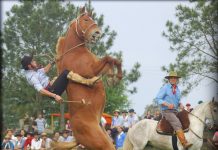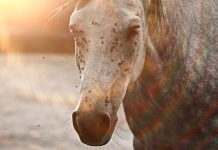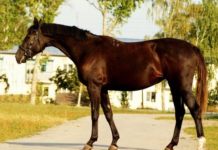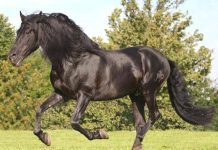The magnificent, gold-colored Palomino horse is actually not a breed, but a color breed.
Breed description

Except in the USA, the Palomino horse is actually not an independent breed but is viewed as a color breed.
The color of the Palomino horses is also known under Isabell here in Europe. Since 1936, the breeding of the palomino in the USA has been monitored and improved.
For breeding purposes, the gold color must not deviate more than 15 percent in either a lighter or darker shade. The Palomino horse is bred for riding and driving.
Size: 140 – 170 cm
Weight: different
Origin: USA
Lifespan: 20-30 years
Color: yellow to golden yellow
Leisure, rodeo, show, western
Origin and breed history
Exactly where the wonderful horses come from is still unclear. The “horses with the golden color” were mentioned for the first time around 200 BC. The emperors of China preferred the gold-colored animals as their riding horses.
In the 16th century, the Spanish conquerors brought the gold-colored horses with them as well as Arabs and Berbers. It is believed that a number of these horses were either left behind or escaped to freedom and reproduced there.
Over time, large herds of beautiful animals emerged. Cowboys discovered the herds with the impressive “yellow” horses and began to capture the most beautiful animals in order to use them for breeding the palominos, the “sun horses”.
The first Palomino studbook was founded in 1932. In 1941, the “Association of Palomino Horse Breeders of America”, the American Palomino Association, was founded.
The origin of the name Palomino horse is also not entirely clear. It is believed that the name could come from the Spanish nobleman Don Juan de Palomino, who was given some of the beautiful horses.
Others suspect that the name of the palomino horse is a modification of the name of a Spanish grape. Palominos are often referred to as “Isabelles”, mainly in Europe.
This name is said to go back to the name of the former Spanish queen Isabella de-Bourbon. Queen Isabella had several palominos in her possession.
These horses were only allowed to be ridden by the Queen herself, her family, and a select group of people. Five mares and one stallion from the Queen’s horse population were later transferred to Don Juan de Palomino in what was then New Spain, now Mexico.
These six palomino horses of the Spanish Queen Isabella can still be found in many pedigrees of the American palominos today. Growing the Palomino color variety is not that easy. The so-called cream gene is responsible for the wonderful golden color of a palomino horse.
This cream gene brightens the color of a chestnut horse. The fur is then yellow to golden yellow, while the mane and tail are cream-colored, white, or even silvery.
This cream gene is not dominant and is not inherited automatically. That means, if two pure palominos are paired with each other, the foal is usually chestnut and not a palomino. On the other hand, mating a Palomino with a chestnut always results in a Palomino foal.
However, these foals are usually darker than desired. Often a palomino horse is mated with an albino, here the offspring is always either an albino or a palomino foal in the desired color.
Traditionally, palominos are still bred in the United States today. Quarter horses are mainly used for breeding here. In addition, horses are used that correspond to the so-called stick type, i.e. the old, heavy “Western horses”.
All horses that correspond to the palomino horse color are listed in the breeding associations. The horse’s height is also a criterion, it must be between 140 cm and 170 cm. The exterior may be different, but must be distinguished by a noble, elegant expression and must not have any defects.
Horses that differ in height by more than 50 cm should not be mated. All horse breeds that are suitable for achieving the breeding goal may be mated.
These include:
- Akhal Teke
- Andalusians
- Arabs
- Western horses
- Various warmblood races
- Cold-blooded animals
- German riding horse breeds
- American races
The appearance of the Palomino
The height of a palomino horse is between 140 cm and a maximum of 170 cm. Characteristic is the wonderful golden fur color, which must not have dark spots, with cream-colored or white to silvery-white hangings.
The curtain may have a maximum of 15 percent dark hair. The eyes of the Palomino horse are dark to hazel brown. Smaller white head badges in the form of blessening, snapping or stars are allowed.
The Palomino horse often has white markings on the legs, but these may only be below the hocks. The head should be impressive and dry, the ears not too big.
The eyes are large and expressive. The building is different because the Palomino horse is not, strictly speaking, an independent breed. As a rule, however, the building falls into the type of Arabs, Quarter Horses or Morgans.
The shoulders are sloping, the back is compact with a strongly muscled croup. The hooves are medium-sized and firm. The Palomino horse has clear limbs, sufficiently large and strong joints, and medium-length pasterns.
The hindquarters should be well angled and the front leg should be straight in profile. The palomino horse does not want an appearance that is too coarse or clumsy, a head that is too coarse, blurred contours, or unclear joints.
The sequence of movements in the Palomino horse must be lively and expansive as well as tactile. The back swings loosely, while the forehand reaches out freely from the shoulder and the thrust from the hindquarters is transmitted over the back.
A firm, inelastic back, and movements that are too short, clumsy, or too flat are undesirable.
Temperament and essence

The Palomino horse inspires with its calm and balanced temperament. Their friendly nature and resilience, intelligence, and quick perception make the Palomino horse an excellent leisure horse, which is also well suited for beginners.
In the USA it is of course very popular for all western equestrian sports and for shows.
Husbandry and nutrition
As with other pets, for example, birds, dogs, or cats, the keeping and nutrition of man’s great friend, the Palomino horse, are crucial for the health of the animal.
A palomino horse is a robust, resilient horse, which is quite suitable for open stable keeping.
A Palomino horse is quite frugal, but you should definitely feed high-quality feed adapted to the needs of your horse.
With the right attitude, good feed, and proper care, a Palomino horse can live to be 30 years or even older.
Education and care
The care of the Palomino horse is limited to the grooming of the coat, the care of the ears, the eyes and ears, and the hooves, as with all other horse breeds.
To do this, you need good brushes that you can buy anywhere in specialist shops. A Palomino horse is easy to train because of its friendly nature, intelligence, and strong nerves.
You are extremely willing to learn.
Health and Typical Diseases
A palomino horse is healthy and robust. If the attitude, care, and nutrition are correct, a Palomino horse is less prone to typical equine diseases.
The life expectancy of the Palomino
Since a palomino horse is not recognized as a breed in most countries, there are hardly any scientific records about the life expectancy of the palominos.
A palomino horse is bred from different breeds. The so-called quarter horses are often used for breeding. This breed of horse is robust, strong, and resilient and can live to a great age.
The media reported about a quarter horse who lived to be 40 years old. Arabs, who are also used for breeding, can also reach an old age of 30 to 40 years. On average, palominos live to be around 30 years old, but there are also older animals.
How old a Palomino horse actually gets depends to a large extent on how it is kept, fed and the level of sporting activity.
Buy Palomino horse
You can actually buy a Palomino horse at any horse market or via private classified ads. Many palominos are offered by private individuals, but also by breeders.
To get a good Palomino horse, look out for the pedigree. In Germany, there are also some registered breeders who specialize in this particular color variety.
Decision support
A palomino horse is obedient, good-natured, and willing to learn.
The friendly nature of the Palomino, the intelligence and quick perception, and the balanced temperament make the Palomino horse a popular leisure horse, which is also ideal for beginners and children.
The palomino horse is also known for its endurance, tenacity, and resilience. It can be used for recreational riding as well as for the various disciplines of western riding.
If you choose a Palomino horse, you will get a reliable, friendly, and intelligent partner at your side who will faithfully carry you through life for many years.
Useful information
The most famous and well-known Palomino horse in the world is probably the Palomino stallion Bamboo Harvester.
Bamboo Harvester played the talking horse Ed in the U.S. comedy series, Mister Ed, from 1960 to 1965. Bamboo Harvester was born in California in 1949 and died in 1968.
Until his death, the beautiful and talented Palomino horse helped to achieve worldwide success as the leading actor in this series. The comedy series comprised 146 episodes, each 25 in length, and ran over six seasons.
The second season, in episode 25, was on April 22, 1962, Clint Eastwood had an appearance that was then almost simultaneously with his own series Rawhide on television.
FAQ about the Palomino

How big does a Palamino get?
Palominos grow to be 140 to 170 cm tall.
What color of fur do Palaminos have?
A Palamino is gold-colored with white or cream-colored markings on the legs, head, and torso.
How heavy is a Palamino?
Palominos weigh between 200 and 300 kg.
What is the life expectancy of the Palominos?
Palominos typically live 20 to 30 years. In exceptional cases, the horse can exceed this age.






























